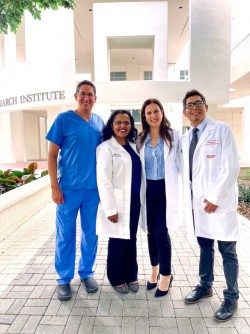Long COVID-19 syndrome, in which symptoms last a year or longer beyond infection, impacts about 30 percent of survivors of the coronavirus. It is a multifaceted systemic condition characterized by fatigue, “cognitive fog,” and often heart, lung and neurological complications.
Lina Shehadeh, PhD, professor of medicine in the Interdisciplinary Stem Cell Institute and Division of Cardiology at the University of Miami Miller School of Medicine, received a $1 million grant from the American Heart Association to study long COVID. Recognizing the substantial public health impact and burden of this syndrome, the American Heart Association awarded three-year grants to 10 research programs in the nation with proposals for unraveling long COVID’s etiology and molecular mechanisms.
“When you have an impact that is systemic — not confined to certain organs — you think about the circulatory system, since its function affects everything else,” Shehadeh said. “We have observed signs that the endothelial function of the blood vessels is abnormal in preclinical models of long COVID. Now, we are working to connect the dots and explain this cascade.”
As part of her research, Shehadeh is using a mouse model and human blood samples to interrogate a chain of events that may account for symptoms seen in people with long COVID. This chain begins with virus-induced lung inflammation and defective cholesterol homeostasis, and ultimately leads to endothelial dysfunction.
The team is investigating evidence that there is an overzealous inflammatory response from the mating of protein spikes on the SARS-CoV-2 virus with low-density lipoprotein receptors (LDLr) on the infected cells. Central to this response is the formation of neutrophil extracellular traps (NETs), which are net-like structures composed of DNA-histone complexes and proteins. These form as the immune system activates an overabundance of neutrophils in the lungs.
While they form as an overreaction to real pathogens like the SARS-CoV-2 virus, they are also complicit in a number of autoimmune diseases, coagulation disorders and thrombus, diabetes, atherosclerosis, vasculitis, sepsis and cancer.
“In COVID-19, when these neutrophils are overwhelmed or defeated by the virus, they burst in the lungs, releasing their DNA material [netosis],” Shehadeh explained. “From there we think the NETs are carried through the systemic circulation and become stuck and then embedded in the vessel walls in the limbs and in the organs. This would explain the loss of normal homeostasis in the vascular walls and the tendency toward thrombus we see so often in COVID long-haulers.”
Shehadeh is working with Jeffrey Goldberger, MD, MBA, professor of medicine and chief of the Cardiovascular Division, and Leonardo J. Tamariz, MD, an internist in the COVID-19 Long-haulers Clinic at the Miami Veterans Affairs Healthcare System. Tamariz is obtaining blood samples and heart and lung MRI images of 150 or so patients from the clinic to sample the neutrophils and check for markers of netosis, while Goldberger is examining the MRIs and other cardiac readouts to assess visible vessel anomalies.
“This ties in with work we have done for years in studying battle fatigue in veterans, which can persist long after they return from the field,” Tamariz said.
Other key team members are Shathiyah Kulandavelu, PhD, a junior faculty member at the Interdisciplinary Stem Cell Institute whose expertise is in endothelial function, and Jose Manuel Condor Capcha, PhD, a postdoctoral associate who is spearheading the lab work.
In this lab, the team is inducing a COVID-19–like response in animal lab models by infecting them with a chimeric virus with a protein spike that mimics that of the SARS-CoV-2. They have previously observed that vascular endothelial dysfunction is prominent in these models. This LDLr-viral bonding also throws cholesterol regulation off-kilter by enriching cell tissue lungs with excess cholesterol.
“When we look at the markers for cholesterol regulation in infected mice, we find the genes involved in cholesterol synthesis are altered. On the surface, it doesn’t make sense because this phenomenon doesn’t involve hypercholesterolemia or hyperlipidemia, so we are investigating this,” Shehadeh said.
Together, their work will test their hypothesis that the long COVID morbidity starts with LDLr mating with the virus, leads to inflammation, netosis and disrupted cholesterol homeostasis, and culminates in endothelial dysfunction. If they observe this pattern repeatedly over time in the mouse model, and if the neutrophil activity from patient samples helps validate these observations, Shehedah says the medical community will have a start in learning how to treat these patients.
“We know netosis is a disaster that causes systemic damage, and currently, steroids are used in many COVID-19 patients to help prevent this inflammatory cascade,” Shehadeh said. “If we understand the full chain of events from inflammatory triggers to the morbidity we see in long COVID, we can work on finding an existing drug or other new therapy that removes these NETs from the vessel walls or prevent endothelial damage to begin with.”
Source: University of Miami Health System, Miller School of Medicine
